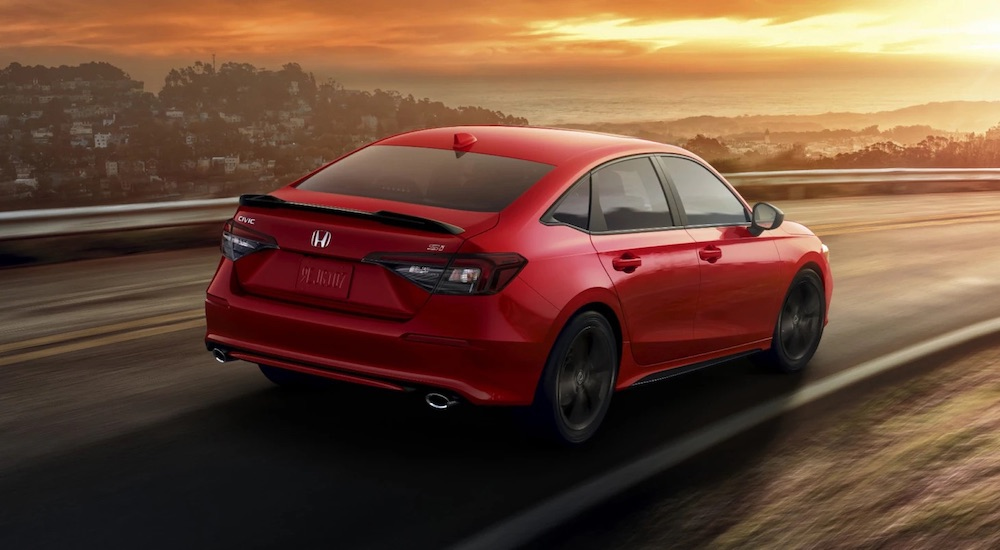With the Civic Si, Honda has taken one of the world’s most popular models and infused it with the sort of sportiness that can turn every drive into an edge-of-your-seat experience. It might not be able to reach some of the high-speed heights of the sportiest Civic variant you will find at your Honda dealer, the Type R, but it also rings in at a good $15,000 less than that high-performance hot hatch. Speaking of value, the Civic Si is also a bargain when compared to its souped-up compact rivals like the Hyundai Elantra N and Volkswagen Golf GTI, offering an economical alternative that cuts no corners to provide an undeniably thrilling ride.
Those doubting the 2025 Civic Si’s performance resume need only to examine the drivetrain. While many automakers have embraced the relatively foolproof automatic transmission––or even the continuously variable transmission (CVT)––for much of their lineups, Honda is sending a clear message about the Civic’s intended use by packaging the 2025 Civic Si exclusively with a six-speed manual transmission. This old-school setup has always been a part of the Civic Si’s unique DNA, and, along with a standard limited-slip differential that reduces slippage while improving steering and acceleration, it marks the Honda as a performance-focused model.
While a manual transmission might stymie some drivers who have never managed to master the mysteries of the clutch pedal, it does offer some distinct benefits in terms of fun, efficiency, and even repair costs. Before you head down to your local Honda dealer to experience the 2025 Civic Si in person, let’s take a moment to learn a little more about some of the advantages of the manual approach and see why Honda’s commitment to this traditional technology gives the sedan such an advantage in today’s market.
More Control
We’ll start with the most obvious advantage of a manual transmission: control. The ability to shift at your leisure gives drivers the chance to precisely harness the engine’s power and torque in a way that an automatic transmission simply cannot match. This can come in particularly handy when trying to navigate steep hills, accelerate from a stop, or tap into the true performance potential of your Civic Si. In addition to tailoring torque and power to a specific driving situation, drivers can also put less wear and tear on their brake pads and rotors by using the transmission to slow the vehicle. This control can help to forge a closer connection between man and machine, giving the driver a chance to learn about their vehicle in a way that those opting for an automatic transmission sadly miss out on.
Simpler Repairs
This simplicity of a manual transmission is another big selling point. Automatic transmissions are a feat of automotive engineering, but they’re also a lot more complex when compared to a manual. This complexity can cost you when it comes time for repairs or maintenance, but that’s not the case with a manual. While there are countless components that can fail in an automatic, a manual transmission’s biggest issue tends to be a worn-out clutch. While a modern clutch will generally last well over 100,000 miles, aggressive driving and poor clutch control can cut that expected lifespan significantly.
Learning Your Car
A manual transmission can also be a real learning opportunity. When you’re behind the wheel of a vehicle with an automatic transmission, you’re basically on autopilot. The transmission makes all your decisions for you, robbing you of the agency that comes with a manual transmission. Understanding the interplay between critical components like the clutch, gearbox, and engine can go a long way toward expanding one’s automotive knowledge, demystifying the inner workings of internal combustion, and providing a solid foundation for further exploration. This understanding can breed more confidence when tackling your own DIY repairs and help a driver better grasp the importance of routine maintenance.
Improved Fuel Economy
The simplicity of a manual transmission translates directly into improved fuel economy. While components like the torque converter and hydraulic pump siphon off power and impact efficiency in vehicles with an automatic transmission, there are simply fewer parasitic parts in a manual. The increased control also plays a part in fuel economy as a driver can take a more active role in limiting fuel usage. If you’re going down a hill, just throw the transmission into neutral, and you’ll be able to coast down the slope without wasting any fuel. While estimates vary, some experts say that a manual transmission can improve a vehicle’s fuel economy by up to 15 percent when compared with an automatic.
Lower Costs
Manual transmissions are not only cheaper to repair and maintain than automatics, but they’re also typically a more affordable option at the time of sale. Again, this largely has to do with a lack of complexity, which tends to translate directly into total production costs. Take the Civic Si’s compact contemporary in the Hyundai Elantra N. The sedan comes standard with a six-speed manual, but Hyundai charges an extra $1,500 to swap it out for an eight-speed automatic.
More Focus
A manual transmission might require a little more attention than an automatic, but that can actually be an advantage in the eyes of some drivers. When driving an automatic, it’s all too easy to become distracted when you’re behind the wheel, but a manual is a different story. Between operating the clutch, selecting the right gear, and performing rev matches, drivers simply don’t have time to shift their attention away from the task at hand. This not only results in a more engaged driving experience, but it can also improve safety and help drivers avoid the sort of accidents that can result from distracted driving.
Better Security
The ability to operate a manual transmission is a dying skill in today’s automotive world. According to data from J.D. Power, only 1.7 percent of vehicles manufactured in 2023 were sold with a manual transmission. That’s a notable decrease from 18 percent in 1995 and 35 percent in 1980, but this drop-off could bring some real benefits in terms of security. The fewer drivers who are familiar with the intricacies of the manual gearbox, the fewer potential thieves who could make off with your car. It might not be the most compelling reason to opt for a manual, but it’s certainly worth considering.
It’s Just Fun
Finally, there’s the fun factor. If you’ve never been behind the wheel of a vehicle with a manual transmission, it might be hard to understand just how thrilling the experience can be. It’s simply a more engaging experience, giving drivers the opportunity to truly feel every burst of horsepower and lb-ft of torque as it makes its way from the engine to the road. A manual also opens the door to new driving tactics, allowing owners to perform some of the tricks they’ve seen in their favorite movies, racing series, or local track days.
Auto Rev Matching
Before we go, we should take a quick moment to mention one of the 2025 Civic Si’s most alluring features. While the standard manual transmission might set it apart from the competition, Honda knows that the manual setup can be a bit of a steep learning curve for some drivers. In order to enhance the Civic Si’s accessibility, the Japanese automaker has outfitted the sedan with a clever rev-match feature that goes a long way toward simplifying the experience. In a vehicle with a typical manual transmission, drivers have to master a technique known as rev-matching. This process involves briefly pressing the accelerator when downshifting in order to match the engine speed to the transmission speed. This allows the transmission to perform a smoother, more efficient gear change while also reducing wear and tear on both the engine and transmission itself.
The ability to perform a seamless rev match can make all the difference when it comes to stop-and-go driving, racing, and other high-speed scenarios, but it has become a bit of a lost art among today’s drivers. Honda has engineered around this issue with the Civic Si’s handy rev-match feature that automatically syncs the engine revs for a flawless shift every time. Prefer a more natural approach? The rev-match feature can be disengaged through the menu on the Civic Si’s nine-inch touchscreen display. The rev-match system allows the Civic Si to offer the best of both worlds, fusing the control of a manual with the foolproof nature of an automatic.
The Perfect Manual Car
The Civic Si is a driver’s car, through and through. The manual transmission might be a little intimidating for those who are accustomed to the convenience of an automatic, but once you get over the hump, it’s hard to go back. The Civic Si’s six-speed manual gearbox lets drivers take full control of all the 200 hp on offer, carving through corners and pushing the limit to turn one of America’s best-selling sedans into a no-holds-barred performance machine. The Civic Si’s rev match feature provides the perfect training tool for those who aren’t yet confident with the manual setup and can be easily disengaged once you’ve started to build some confidence. Whether you’re looking for enhanced control, cheaper repairs and maintenance, improved fuel economy and security, or just looking to increase your automotive knowledge from the inside out, the 2025 Honda Civic Si and its six-speed manual transmission provide the perfect platform.






